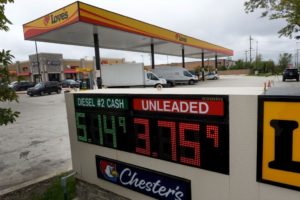President Joe Biden’s six-month plan to lower gasoline prices by tapping into the nation’s emergency oil reserves is coming to an end. The current administration is patting itself on the back, celebrating ahead of the midterm elections that using the Strategic Petroleum Reserve (SPR) helped send a gallon of gasoline down 28%. Did the move actually make a difference to gas prices? Not really. What did, then? Demand destruction and recession fears. But tapping into the SPR achieved something else: leaving the US energy situation vulnerable to an actual emergency.
1984: Oil Reserves Edition
 US emergency crude oil inventories tumbled by 8.4 million barrels to 434.1 million for the week ending Sept. 9, according to recent data from the Department of Energy (DOE). This represented the lowest level since early November 1984, and it was the sharpest withdrawal – 6.3 million barrels of sweet crude and two million barrels of sour crude – since May.
US emergency crude oil inventories tumbled by 8.4 million barrels to 434.1 million for the week ending Sept. 9, according to recent data from the Department of Energy (DOE). This represented the lowest level since early November 1984, and it was the sharpest withdrawal – 6.3 million barrels of sweet crude and two million barrels of sour crude – since May.
Although the president’s initiative is set to expire soon, the White House has unofficially extended the deadline. The Energy Department issued a Notice of Sale announcement of up to ten million barrels of crude from the federal government’s rainy-day oil fund to “address the global supply disruption caused by Putin’s energy price hike.” This enormous sale, which includes up to five million barrels from SPR site Big Hill in Texas and another five million barrels from West Hackberry in Louisiana, will be for November deliveries. The decision comes soon after Energy Secretary Jennifer Granholm revealed to Reuters that officials were mulling over an extension to release more supply from the SPR.
In March, President Biden unveiled a campaign to release one million barrels per day (bpd) from the SPR to help curb prices, especially in China and Europe, as those regions were key destinations for oil sales. At the time, many industry analysts scoffed at the proposal, arguing the move would hardly make a dent. They were right; prices continued edging higher, eventually topping $5.012 per gallon. The president seems to believe there is a case of cause-and-effect occurring as gas prices fall – but what is really behind this decline?

(Photo by Brandon Bell/Getty Images)
From a barrel of West Texas Intermediate (WTI) crude to a gallon of gasoline, prices have erased their post-Ukraine invasion gains due to multiple factors. First, US consumer demand for gas has plunged, falling to the pandemic levels of July 2020. China’s lockdowns have seen Beijing’s crude imports fall by double digits. Global recession fears spooked investors to panic and hit the sell button. Still, since Biden has been largely blamed for skyrocketing commodity prices, it is only fair – politically – that he takes credit for the downward trend. This is Politics 101.
“If I’m the president or if I ruled the world and gas prices were going down heading into the election, I would 100% take credit for it — despite not having anything to do with it,” Denton Cinquegrana, chief oil analyst at the Oil Price Information Service (OPIS), told Money.com.
A Temporary Respite
Whether the SPR release is concluding soon or not remains to be seen. The energy industry is preparing for the end, causing domestic refiners to turn to Canadian oil this fall – at a time when global supplies are tight. This could lead to exceptional volatility, warns Phil Flynn, a strategist and author of The Energy Report. “The coming end of SPR releases could shift market dynamics again in a year of high volatility following Russia’s invasion of Ukraine in February,” he wrote. “The SPR is running out of product to supply the market as we head into winter and this market is going to be faced with a huge reality check. If we get a colder-than-normal winter, I fully expect to see oil prices come close to testing all-time highs and that goes for the natural gas market as well.”

(Photo by Scott Olson/Getty Images)
But even if drawing down from the SPR successfully lowered energy prices, this was not the program’s objective in the first place. It was established under President Gerald Ford in 1975 to mitigate future supply disruptions, not to save motorists money heading into election season. Indeed, the United States still possesses plenty of supply as it was previously energy independent. Today, the country produces about 12 million bpd and could increase output by a considerable amount.
Bailouts
By tapping into the SPR, Biden instituted a precedent of using emergency stocks to bail himself out of disastrous energy policies, such as killing the Keystone XL pipeline and derailing production efforts. In the future, any of his successors can employ the same strategies, particularly right before election season. Therefore, the SPR is no longer a rainy-day fund to keep on the lights. Instead, it is a bailout slush fund for any Republican or Democrat leader to utilize as he or she sees fit. Is it any wonder that officials warn reserves could dwindle to as low as 238 million barrels by 2028?




